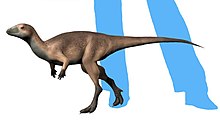Haya griva
| Haya griva | |
|---|---|

| |
| Life restoration of H. griva | |
| Scientific classification | |
| Domain: | Eukaryota |
| Kingdom: | Animalia |
| Phylum: | Chordata |
| Clade: | Dinosauria |
| Clade: | †Ornithischia |
| Clade: | †Neornithischia |
| Family: | †Thescelosauridae |
| Subfamily: | †Thescelosaurinae |
| Genus: | †Haya Makovicky et al., 2011 |
| Species: | †H. griva
|
| Binomial name | |
| †Haya griva Makovicky et al., 2011
| |
Haya is an
Description
Haya is known from several well-preserved specimens which collected in the Khugenetslavkant locality by the joint Mongolian Academy of Sciences from 2002 to 2007, from the Javkhlant Formation and a few from the Zos Canyon locality of the Gobi Desert. Both localities probably date to the Santonian-Campanian stages of the Late Cretaceous. The holotype IGM 100/2017 is composed of a complete and well preserved skull with some postcranial elements associated to it. Referred materials include IGM 100/1324, isolated left femur, IGM 100/2013, postcranial elements, IGM 100/2014, a crushed skull and postcranial elements, IGM 100/2015, a nearly complete postcranial skeleton, IGM 100/2016, a partial juvenile skull, IGM 100/2018, an isolated mandible with some teeth, IGM 100/2019, a nearly complete skull and skeleton and IGM 100/2020, postcranial fragments. One skeleton of Haya, IGM 100/2015, preserves a large mass of gastroliths.
Etymology
Haya was first named by Peter J. Makovicky, Brandon M. Kilbourne, Rudyard W. Sadleir and Mark A. Norell in
Phylogeny
A
In 2021, Daniel E. Barta and Mark A. Norell carried out a detailed analysis of the phylogenetic position of Haya, recovering Haya outside of Jeholosauridae, and instead as part of Thescelosauridae.[4]
